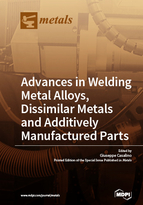Advances in Welding Metal Alloys, Dissimilar Metals and Additively Manufactured Parts
A special issue of Metals (ISSN 2075-4701). This special issue belongs to the section "Additive Manufacturing".
Deadline for manuscript submissions: closed (31 August 2016) | Viewed by 119611
Special Issue Editor
Interests: advanced manufacturing; welding and joining; additive manufacturing
Special Issues, Collections and Topics in MDPI journals
Special Issue Information
Dear Colleagues,
Welding is a material-joining process, commonly associated with metals, in which two or more parts are coalesced at their contacting surfaces by a suitable application of heat and/or pressure. Welding techniques are innovative, well established, and their combinations are available to join materials with a number of geometries, which provide an opportunity to solve many engineering problems.
Metals is dedicating a Special Issue on the following aspects of welding technologies: modeling and simulation; evolution of microstructure and properties in welds; prediction of residual stress, distortion, fatigue, and corrosion; weld quality and qualification; and destructive and non-destructive control.
Papers on laser welding, friction stir welding, electron beam welding, arc welding, and hybrid welding are welcome. In particular, the journal will be pleased to publish research on light metal alloys, dissimilar metals, and additively manufactured parts.
Contributions from around the world will contribute to the success of this Special Issue, which aims at spreading the potential of advanced welding at joining well-established and innovative metallic parts.
Dr. Giuseppe Casalino
Guest Editor
Manuscript Submission Information
Manuscripts should be submitted online at www.mdpi.com by registering and logging in to this website. Once you are registered, click here to go to the submission form. Manuscripts can be submitted until the deadline. All submissions that pass pre-check are peer-reviewed. Accepted papers will be published continuously in the journal (as soon as accepted) and will be listed together on the special issue website. Research articles, review articles as well as short communications are invited. For planned papers, a title and short abstract (about 100 words) can be sent to the Editorial Office for announcement on this website.
Submitted manuscripts should not have been published previously, nor be under consideration for publication elsewhere (except conference proceedings papers). All manuscripts are thoroughly refereed through a single-blind peer-review process. A guide for authors and other relevant information for submission of manuscripts is available on the Instructions for Authors page. Metals is an international peer-reviewed open access monthly journal published by MDPI.
Please visit the Instructions for Authors page before submitting a manuscript. The Article Processing Charge (APC) for publication in this open access journal is 2600 CHF (Swiss Francs). Submitted papers should be well formatted and use good English. Authors may use MDPI's English editing service prior to publication or during author revisions.
Keywords
- advanced welding
- metal alloys
- dissimilar weld
- additively manufactured parts
- evolution of microstructure
- properties in welds






